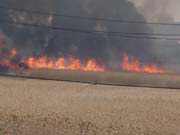A mammoth fire, possibly ignited by a careless cigarette, burned ferociously through the dry brush behind Tonnelle Avenue in North Bergen for six hours last Sunday, displaying flames that shot some 25 feet in the air, producing a dark smoke that could be spotted for miles and causing a traffic and commuter nightmare that lasted for two days.
According to North Hudson Regional Fire and Rescue Co-Director Jeff Welz, the fire was brought under control in fairly rapid fashion, utilizing 13 NHRFR vehicles and five from neighboring Secaucus, but it caused its share of headaches for everyone.
“The fire had a major impact on traffic,” Welz said. “We had to close all of the major highways, Route 1&9, an section of Route 3, and exit 17 of the New Jersey Turnpike, at one point or another. Amtrak lines were shut down, as were NJ Transit lines and the Conrail (now known as CSX Freight) lines. There was a major inconvenience for motorists, for train commuters. All because of what appears to be one cigarette.”
Welz said that an official cause of the two square mile blaze had yet to be determined, but the report reads, “a careless discarded smoking material.”
“That’s good enough cause for us,” Welz said. “A witness said that he saw someone flicking a cigarette from the window of a bus and the next thing he knew, he saw gigantic flames.”
Two other factors played into the size of the blaze, which remarkably caused no injuries and no structural damage to any neighboring properties. Every year at this time, the high marsh brush grass is essentially the dead remnants from the prior year.
“The marsh grass dies over the winter and dries up,” Welz said. “The new growth hasn’t been able to push the old out, so we have a period of time, from late April until June, where the dry grass causes concern. Plus, we went 13 days without rain at all, so that grass was extremely dry and that grass burns easily.”
Added Welz, “There were extremely high winds that helped fuel the fire, helping it to spread rapidly. It moved at a tremendously fast rate, even moving against the wind at one point. Fire companies had to guess where the fire was going to go next, so with the wind blowing north, we figured the fire would burn in that direction. But this fire was so intense that it burned south, even with the high wind blowing from the south.”
The fire delayed or aborted runs by 30 NJ Transit trains, according to NJ Transit spokesman Ken Miller. And New York-bound rail commuters were advised to take PATH trains to Newark or Hoboken and make cross-river connections from there.
Amtrak passenger service came to a halt for a period of time as well.
Welz said that approximately 50 firefighters were called upon to fight the fire, as well as an undetermined amount of Secaucus volunteers.
NHRFR Deputy Chief Robert Hodge said that there was a very tactical approach to combating the blaze. “We had a division set up at the northern end and another at the southern end of the fire,” Hodge said. “We had to also protect any buildings that could possibly become exposed to it.”
The main concern was the Walsh Trucking Company, located near 16th Street and Tonnelle Avenue.
“Considering that there isn’t much of a water supply there, we had to shuttle pumpers in and make sure that the buildings were protected,” Hodge said. “Some of the flames did get close to the roadside, especially near parts of Route 3, so there was a potentially dangerous situation. With the shifting winds and the grass being so dry, anything could have happened. It was a complex fire to fight.”
Welz said that the three-alarm blaze forced the regional to ask Jersey City for help as well, to be on call in case a fire broke out in the residential area of the region, while the majority of the department was fighting the intense brush fire.
“Because we made a very tactical response, we were able to keep the fire from jumping around,” Welz said. “It really was a phenomenon, with the dark smoke and the high flames, some of which were 25 feet in the air. With the strong wind current, it made things very difficult. I highly commend the actions of the regional, especially Deputy Chief Eric Iauen and Deputy Chief Robert Hodge. Chief Edward Flood was also on the scene and offered assistance. They all knew right away how to handle the fire.”
Welz also commended the work of the North Bergen and Secaucus police, the State Police, and the Port Authority of New York/New Jersey police for their patience with the traffic woes.
Welz said that the problems are far from over. Other marsh fires could spring up at a moment’s notice from the spark of a train, perhaps even from a piece of glass reflecting the sun.
“We still have a month to go to watch for fires,” Welz said. “We’re working with the New Jersey Forest Rangers for the best way to deal with a fire with no accessibility.”
In that respect, the NHRFR is not out of the weeds, so to speak, just yet.
